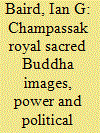| Srl | Item |
| 1 |
ID:
157220


|
|
|
|
|
| Summary/Abstract |
What is the relationship between Buddha images and the legitimization of political power over space? What understandings exist amongst royals concerning regaining spatial power associated with Buddha images? This article considers these questions with a particular focus on the Champassak Royal House, a royal family that was originally spatially constituted through the territorial control it had over present-day southern Laos and some neighbouring areas. To do this, the article draws upon two case studies, one centred on an important Buddha image in the 18th century, the other more contemporary and linked to Buddha images and exiled members of the Champassak Royal House. Buddha images have long played an important role in constituting and defining sacred geographies, and thus political power, in Champassak, as has similarly been the case in other parts of mainland Southeast Asia.
|
|
|
|
|
|
|
|
|
|
|
|
|
|
|
|
| 2 |
ID:
112244


|
|
|
|
|
| Publication |
2012.
|
| Summary/Abstract |
The aim of this paper is to examine the economic impact of the royalty reform. The draft Turkish petroleum Law introduces two important fiscal changes to increase to increase domestic petroleum production, further national petroleum supply, attract investors and harmonize its laws with those of the European Community: (1) progressive sliding royalty relief on oil and gas production leases and (2) 50% of the royalty shall be transferred to province where the production lease exists.Results included in this analysis indicate that there would be 2% increase in oil production thanks to 128 oil fields extending economic life and 0.5% increase in gas production thanks to 63 gas fields due to their profitability in the forecasted period. Half of royalty is transferred to low per capita income provinces and tends to contribute distribution of income. However, half of gas royalty is transferred to high income per capita provinces.
|
|
|
|
|
|
|
|
|
|
|
|
|
|
|
|
| 3 |
ID:
113237


|
|
|
|
|
| Publication |
2012.
|
| Summary/Abstract |
This paper seeks to discuss Malay identity as it has been understood by the Malay Muslim religious elites (the Ulama) in Malaysia. I posit that the Ulama's voices have been privileged in the context of the Islamic resurgence period. Although there has been a general consensus by the Ulama that Islam is a key component of the Malay identity and that the two are inseparable, the Ulama are, at present, divided in the contest for a clear definition of what 'Islam' is and how Malayness can be refashioned towards Islam. By couching these debates and contestations within the context of the Islamic resurgence period and the state's Islamisation project, I shall highlight the ways in which issues such as Malay rites, rituals and cultural practices, and what constitutes bid'ah (sinful innovations) in Islam are elucidated. The works and sermons of three key Ulama in contemporary Malaysia-Nik Aziz, Mohd Asri, and Harussani Zakaria-shall be treated as case studies. Their attitude towards other key markers of Malayness, such as the Malay Royalty and Malay language, and how they are negotiated in relation to Islam are also examined.
|
|
|
|
|
|
|
|
|
|
|
|
|
|
|
|